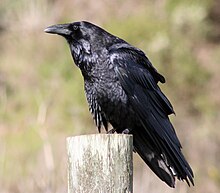Ravens
Appearance
(Redirected from Raven)

Ravens are any of several larger-bodied members of the genus Corvus. These species do not form a single taxonomic group within the genus, but share similar characteristics and appearances that generally separate them from other crows. The largest raven species are the common raven and the thick-billed raven.
Quotes
[edit]- Raven, raven, your eggs are shining bright!
Raven bird, your eggs are shining bright!
Where do people carry off your holy eggs?
- That Raven on yon left-hand oak
(Curse on his ill-betiding croak)
Bodes me no good.- John Gay, Fables (1727), The Farmer's Wife and the Raven.
- Kahgahgee, the King of Ravens,
Gathered all his black marauders,
Crows and blackbirds, jays and ravens,
Clamorous on the dusky tree-tops.- Henry Wadsworth Longfellow, The Song of Hiawatha (1855), Part XIII
- The Raven's house is built with reeds,—
Sing woe, and alas is me!
And the Raven's couch is spread with weeds,
High on the hollow tree;
And the Raven himself, telling his beads
In penance for his past misdeeds,
Upon the top I see.- Thomas D'Arcy McGee, The Penitent Raven; reported in Hoyt's New Cyclopedia Of Practical Quotations (1922), p. 656.
- The raven once in snowy plumes was drest,
White as the whitest dove's unsullied breast,
Fair as the guardian of the Capitol,
Soft as the swan; a large and lovely fowl
His tongue, his prating tongue had changed him quite
To sooty blackness from the purest white.- Ovid, Metamorphoses, Story of Coronis. Addison's translation; reported in Hoyt's New Cyclopedia Of Practical Quotations (1922), p. 656.
- Ghastly, grim, and ancient Raven, wandering from the Nightly shore,—
Tell me what thy lordly name is on the Night's Plutonian shore!
Quoth the Raven "Nevermore!"- Edgar Allen Poe, The Raven (1844), Stanza 8.
- And the Raven, never flitting,
Still is sitting, still is sitting
On the pallid bust of Pallas
Just above my chamber door;
And his eyes have all the seeming
Of a demon's that is dreaming,
And the lamplight o'er him streaming
Throws his shadow on the floor,
And my soul from out that shadow,
That lies floating on the floor,
Shall be lifted—nevermore.- Edgar Allen Poe, The Raven (1844), Stanza 18.
- The croaking raven doth bellow for revenge.
- William Shakespeare, Hamlet (1600-02), Act III, scene 2, line 264.
- The raven himself is hoarse
That croaks the fatal entrance of Duncan
Under my battlements.- William Shakespeare, Macbeth (1605), Act I, scene 5, line 40.
- O, it comes o'er my memory,
As doth the raven o'er the infected house,
Boding to all.- William Shakespeare, Othello (c. 1603), Act IV, scene 1, line 20.
- Did ever raven sing so like a lark,
That gives sweet tidings of the sun's uprise?- William Shakespeare, Titus Andronicus (c. 1584-1590), Act III, scene 1, line 158.


